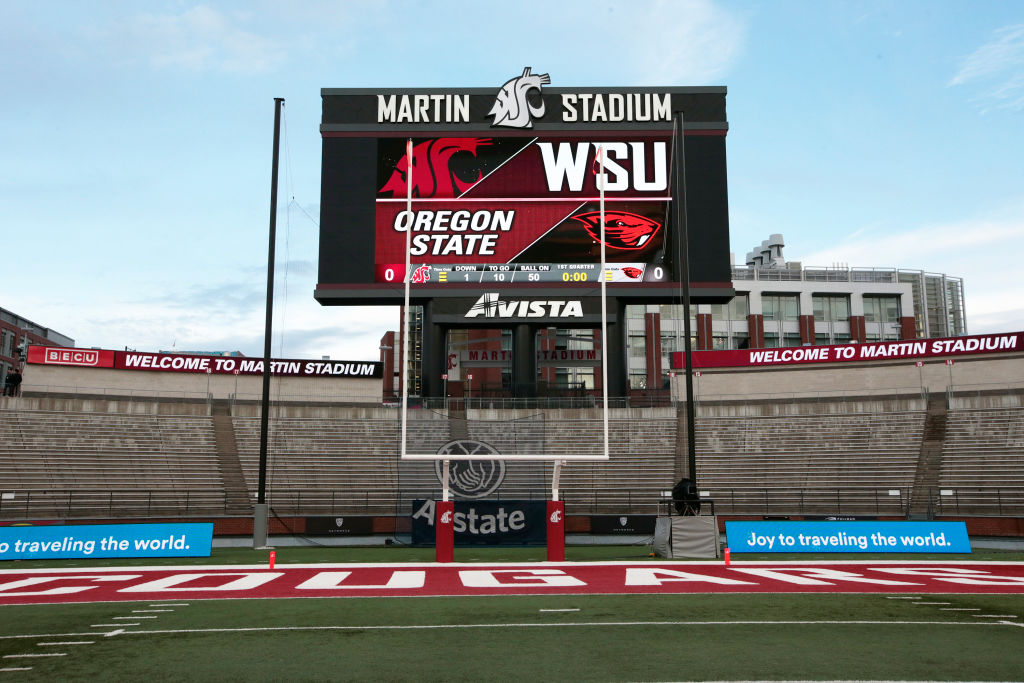The college football "super league" scheme now has more of a skeletal structure thanks to a pitch deck reported on by Daniel Libit and Eben-Novy Williams of Sportico, and other than the motivations behind this new leak, the interesting hook is the disinterment, revivification and restoration of the Pac-12 Conference.
The West Coast's attempt to hold a place in a new southeastern/midwest axis of influence failed when their ramshackle but ancestral home was dynamited by a joint effort of the TV networks and their own multiple layers of stupidity. Made ridiculous by bad leadership and a worse conference TV network seen by nobody, the Pac-12 splintered itself. USC and UCLA fled to the Big Ten. Colorado, Utah and the two Arizona schools left for the Big 12. Oregon and Washington chased the L.A. schools—or as we now know them, USC and The Other One. And Cal and Stanford went to the Atlantic Coast Conference, presumably because they couldn't get into La Liga.
This left Oregon State and Washington State, the two conference members no other conference wanted, royally betrayed and screwed simultaneously. Even though they got to keep the Pac-12's remaining money, they were still looking at a forlorn future either in the Mountain West, Big Sky, or their own two-team intramural league playing each other 12 times a year—13, if you count the bowl game the two would always schedule.
But with this plan, which still has the one disadvantage that the SEC and Big Ten don't want to put 30 more forks in the pie they're baking, Oregon State and Washington State are suddenly repatriated and unscrewed. They sit in what the would-be power brokers, College Sports Tomorrow, cleverly term the West Division, one of seven 10-team groupings that form a 70-team (we're no longer referring these things as schools because we feel measurably more gullible when we do) amalgamation of permanent members who can never be relegated to what the leaked document insultingly terms "the Under League"—the eighth division of non-permanent members who can be relegated and promoted on a yearly basis.
And while we can only laugh at the notion that this plan was or is going to be greeted with anything other than contemptuous dismissal by the SEC and Big Ten hammers, we find the restoration of the core of the Pac-12 and especially Oregon State and Washington State particularly hilarious. The SEC, Big Ten and the networks already expressed their spit-soaked views of the Pac-12 when they raided its members, so what exactly makes this more appealing to them?
True, this seems like a propitious lifeline for the Beavers and Coogs, since they would get to return to the place where they both started in the 1910s. But their re-inclusion swims upstream against the giants' long-term plan of reducing the number of major college football participants not from 130 to 70 but to maybe 40. The media deals aren't going to swell with OSU and WSU or their like; they're just going to make Alabama's and Ohio State's slices thinner, and they didn't go to all this trouble to eat less.
The leaked deck is, ultimately, a starting point for a negotiation where one side possesses all the supply and leverage and has no interest in returning any of it. For those college football structure-philes who all of a sudden miss the NCAA because they figure even a bad cop on the beat is still better than no cop at all, the current chaos is untenable. But for the SEC and Big Ten, who are their own police department, legal arm, political system and chamber of commerce in this analogy, the idea of recreating a new middleman to replace the old middleman they all hated and then outgrew is a self-perpetuating absurdity.
But at least this all gives Oregon State and Washington State a reason to feel a little less abandoned—for a minute or two, anyway.






